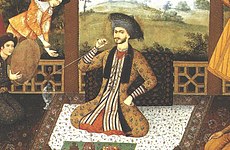
Back سليمان الأول Arabic سليمان الاول الصفوى ARZ I Süleyman (Səfəvi) Azerbaijani شاه سلیمان AZB Sulayman I de Pèrsia Catalan شا سولەیمانی یەکەم CKB Safí II. Czech Safi II. German Σουλεϊμάν Α΄ της Περσίας Greek Solimán I de Persia Spanish
| Suleiman I | |
|---|---|
 Suleiman I, painted by Aliquli Jabbadar in 1670. | |
| Shah of Iran | |
| Reign | 1 November 1666 – 29 July 1694 |
| Coronation | First coronation: 1 November 1666 Second coronation: March 1668 |
| Predecessor | Abbas II |
| Successor | Soltan Hoseyn |
| Born | Sam Mirza February/March 1648 |
| Died | 29 July 1694 (aged 46) Isfahan, Iran |
| Burial | Fatima Masumeh Shrine, Qom, Iran |
| Issue | Soltan Hoseyn Zobeydeh Khanum[1] Shahrbanu Begum[2] |
| House | Safavid dynasty |
| Father | Abbas II |
| Mother | Nakihat Khanum |
| Religion | Shia Islam |
Suleiman I (Persian: شاه سلیمان, romanized: Shah Solayman; born Sam Mirza, February or March 1648 – 29 July 1694) was the eighth Shah of Safavid Iran from 1666 to 1694. He was the eldest son of Abbas II and his concubine, Nakihat Khanum. Born as Sam Mirza, Suleiman spent his childhood in the harem among women and eunuchs and his existence was hidden from the public. In 1666, after the death of his father, the nineteen-year-old Sam Mirza was crowned king under the regnal name, Safi II, after his grandfather, Safi I. He had a troublesome reign as Safi II, which convinced his court astrologers that he should undergo a coronation once again. Thus, in 20 March 1668, simultaneously with Nowruz, he was crowned king with a new name, Suleiman I.
After his second coronation, Suleiman retreated into his harem to enjoy sexual activities and excessive drinking. He was indifferent to the state affairs, and often would not appear in the public for months. Suleiman's reign was devoid of spectacular events in the form of major wars and rebellions. For this reason, Western contemporary historians regard Suleiman's reign as "remarkable for nothing" while the Safavid court chronicles refrained from recording his tenure. Suleiman's reign saw the decline of the Safavid army, to the point when the soldiers became undisciplined and made no effort to serve as it was required of them. At the same time, the eastern borders of the realm was under the constant raids from the Uzbeks, and the Kalmyks.
On 29 July 1694, Suleiman died from a combination of gout and his chronic alcoholism. Often seen as a failure in kingship, Suleiman's reign was the starting point of the Safavid ultimate decline: weakened military power, falling agricultural output and the corrupt bureaucracy, all were a forewarning of the troubling rule of his successor, Soltan Hoseyn, whose reign saw the end of the Safavid dynasty. Suleiman was the first Safavid Shah that did not patrol his kingdom and never led an army, thus giving away the government affairs to the influential court eunuchs, harem women and the Shi‘i high clergy. Perhaps the only admiring aspect of his reign was the appreciation of art, for the Farangi-Sazi, or the Western painting style, saw its zenith under Suleiman's sponsorship.
- ^ Floor, Willem (2005), "A Note on The Grand Vizierate in Seventeenth Century Persia", Zeitschrift der Deutschen Morgenländischen Gesellschaft, 155 (2), Harrassowitz Verlag: 435–481, JSTOR 43382107
- ^ Kissling, H. J.; Spuler, Bertold; Barbour, N.; Trimingham, J. S.; Braun, H.; Hartel, H. (1 August 1997). The Last Great Muslim Empires. BRILL. p. 210. ISBN 978-9-004-02104-4.